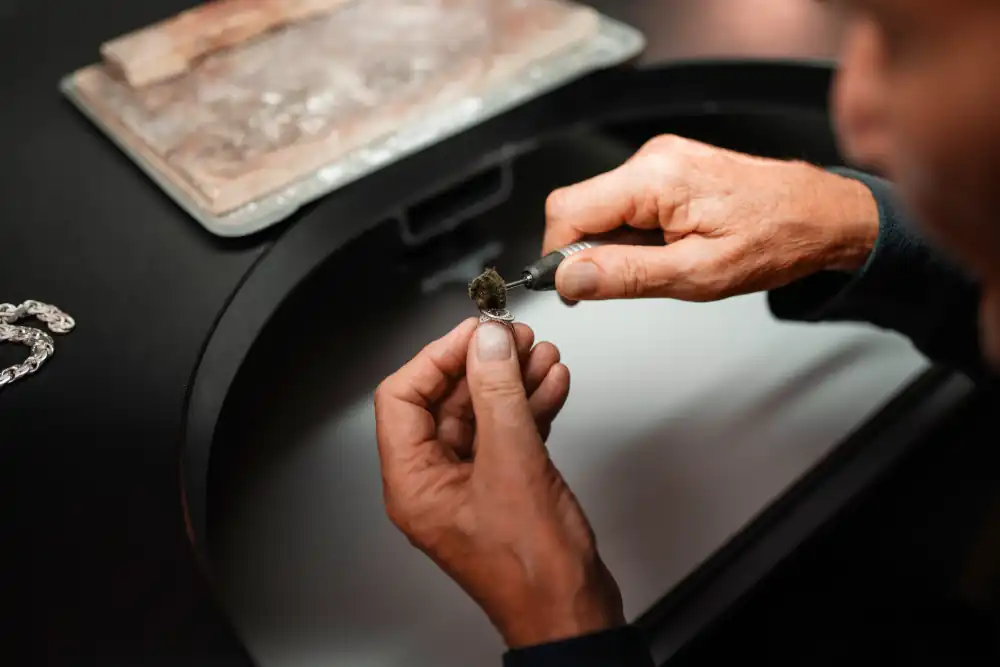
Free UK shipping and returns
250,000+ Happy Customers
Express Next Day UK Delivery
Worldwide Shipping
Subscribe & Get 10% off your first order!
Lifetime Warranty on All Items
Have you ever gazed at a beautiful piece of jewelry and wondered about the tiny markings it bears? Among the most common inscriptions, 925 stands out, often tucked away in a corner or hidden on an intricate clasp. But what does this number truly signify? Beyond being just another stamp, it opens the door to understanding the quality and authenticity of precious metals. When you look through your jewelry collection or think about buying something new, understanding what 925 means can help you appreciate these classic pieces more.
In a world where fake luxury often looks real, it’s important to understand the markings on your accessories. This article will explain what does 925 mean on jewelry? Also it will focus on its role in silver purity and how it affects your buying choices. We will discuss the meaning of this stamp. Plus, why it is important for finding quality jewelry that lasts a long time.
The term 925 stamped on jewelry signifies that the piece is made of sterling silver. According to wikipedia it means that it contains 92.5% pure silver, along with 7.5% of other metals, usually copper. It’s also called s925 jewelry.
The inclusion of copper enhances the durability of the silver, making it less prone to scratches and tarnishing. Additionally, this alloy contributes to a lovely sheen that many find attractive in jewelry pieces.
What’s interesting is that the 925 standard has become a symbol of quality in the jewelry industry. When you see a piece marked with 925, you can be confident in its composition and craftsmanship.
For anyone shopping for silver jewelry, understanding what does the number 925 mean on jewelry? is essential. It assures buyers they are getting a quality product that combines beauty with strength.

Some people wonder what does 925 mean on jewelry gold?
When you stumble upon a piece of jewelry marked with 925, your first thought might be that it boasts an impressive gold content of 92.5%. However, this assumption often leads to the wrong conclusion. In reality, 925 is a hallmark typically associated with sterling silver, indicating that the piece is 92.5% pure silver and 7.5% other metals like copper. So, if you’re viewing what appears to be gold jewelry with this mark, there’s a good chance it’s actually not solid gold at all!
Instead of gleaming in pure gold glory, these pieces are frequently made from 925 sterling silver and simply plated with a thin layer of gold for that luxe appearance without the hefty price tag. This isn’t necessarily bad news! Gold-plated items can look stunning and affordable while still allowing wearers to enjoy fashionable pieces without breaking the bank.

Have you wondered what does 925 mean on jewelry with diamonds? If you see a 925 stamp on jewelry, especially diamond-studded pieces, it’s like discovering a little treasure of quality assurance. This marking means that the metal is primarily sterling silver, which consists of 92.5% pure silver—hence the name 925.
But here’s the fun part! Using sterling silver as the foundation for diamond settings not only looks stunning but also adds to the durability of the piece. It provides a lovely backdrop for your diamonds to shine against and keeps them securely in place.
What does 925 mean on jewelry silver? The 925 mark on jewelry serves as an assurance of quality. This standard started in Europe and dates back to the 13th century. It was important for making sure silver items had a certain level of purity. Countries began using strict testing methods to verify this standard, which built trust in items marked with 925.
Beyond its significance as a quality hallmark, it has a rich history linked to skilled craftsmanship. Jewelry makers who use this mark honor old traditions, where each piece tells a story from the past. Today, wearing 925 jewelry means more than just enjoying its beauty or strength. It also connects you to values of art and integrity in craftsmanship. So, when you see jewelry with the 925 stamp, remember you are holding a piece of history and tradition.
While the 925 mark is widely recognized as a sign of quality silver, there are several other hallmarks that signify craftsmanship and purity in silver jewelry. For instance, the term Coin Silver typically refers to an alloy comprising 90% silver and was commonly used in American coinage prior to 1965. The “800” mark indicates silver that is 80% pure, often found in European pieces made before stricter regulations came into play. These markings offer insight into both historical practices and regional variations in silversmithing.
In addition to purity standards, you may also encounter country-specific marks, like the British lion passant, which signifies that the piece is made of sterling silver and was manufactured in the United Kingdom.
Each hallmark tells a unique story about the craftsmanship behind it. For instance, marks from Italy might showcase intricate designs that reflect its rich artistic heritage. On the other hand, German hallmarks often emphasize precision and meticulous attention to detail.
Learning about common silver hallmarks improves your collection and helps you appreciate the art behind it. Each mark links you to the skilled artisans who dedicated time and passion to make these beautiful pieces.
When it comes to silver jewelry, understanding the hallmark can greatly impact your buying decisions. While you may have stumbled upon “925” stamped on some of your favorite pieces, it’s essential to know what that actually means compared to other hallmarks:
Silver jewelry with a 925 stamp means it has 92.5% pure silver. This quality makes it strong and attractive. In contrast, lower grades like 800 or 835 can tarnish faster and don’t shine as brightly. The high purity of 925 keeps it looking beautiful for a long time.
Many people don’t realize that the 7.5 in sterling silver is mostly copper. Copper makes the silver stronger and gives it a unique look as it ages. This aging process adds character to each piece. Also let wearers enjoy the personal changes in their jewelry over time.
Looking at different hallmarks can show many types of craftsmanship. For example, 950 means higher purity, often seen in handmade items, but these can scratch and dent easily. On the other hand, pieces marked Argentium have better resistance to tarnish because they contain germanium. This is a good choice for those who want both practicality and style.
Ultimately, understanding what does s925 mean on jewelry empowers consumers to make informed choices about their purchases while embracing the artistry behind silver jewelry beyond just sparkle and shine.
When you’re on the hunt for genuine s925 jewelry, understanding how to distinguish it from fakes is paramount. One effective method is to look for specific markings; authentic sterling silver usually bears a 925 stamp, indicating that it consists of 92.5% pure silver mixed with metals like copper for added durability. However, not all genuine pieces may have this marking due to design choices or alterations made post-purchase.
To further enhance your savvy shopping skills, consider these crucial points:
Real sterling silver will not be magnetic; if a piece sticks to a magnet, it’s likely not genuine.
Monica Jamison shared her thoughts on Quora, “It will have 925 marked on it. Or if its old assay marks. And if you can pick it up with a magnet, it’s not silver.”
Authentic silver has a certain heft and smoothness that lower-quality imitations lack.
Genuine 925 silver will tarnish over time but can be easily cleaned; fake designs often don’t show any signs of aging.
Before finalizing your purchase, always try to know what does the 925 mean on jewelry silver and trust your instincts and inspect the craftsmanship closely. A piece that feels cheap or looks poorly made might not be the real deal.

When it comes to 925 silver, many people carry around a few misconceptions that could be illuminating. One major myth is that 925 silver is “pure” silver, when in fact, the term refers to the alloy composed of 92.5% silver and 7.5% other metals—commonly copper. This mixture not only enhances the durability of the jewelry but also allows for intricate designs without compromising strength. So, thinking that all sterling jewelry is pure can lead to some misunderstandings about quality and craftsmanship.
Another myth floating around is that 925 silver can’t tarnish at all. While it’s more resistant to tarnishing than pure silver due to those added metals, it isn’t entirely immune. Over time and exposure to air or moisture, you might notice a little dullness creeping in—but don’t worry! A simple polishing cloth can bring back its sparkle like magic. Embracing imperfections like tarnish can even add character to your pieces—think of it as the fingerprint of life adventures etched onto your favorite accessories!
Many might also believe that because it’s alloyed with copper, 925 silver easily turns their skin green. While this can happen if a piece isn’t properly cared for or if you have an allergy to certain metals, high-quality sterling tends not to react negatively with skin when maintained well. Embracing these facts about 925 silver helps you appreciate its beauty while ensuring you’re making savvy purchasing decisions!
Authenticity in jewelry serves as a testament to quality and craftsmanship. It creates trust between artisans and consumers. When you purchase authentic pieces, you’re not just acquiring adornments; you’re investing in the story behind that piece—its origin, materials, and the artistry involved. It helps with:
Moreover, authenticity fosters sustainability within the industry. By choosing certified pieces marked with symbols like the 925 stamp, consumers support ethical practices and reduce demand for subpar imitations that harm both creators and customers alike.
In conclusion, the significance of knowing what does s925 on jewelry mean is something else! 925 in jewelry goes beyond just a number—it represents quality, trust, and timeless elegance. Knowing that you’re wearing sterling silver gives you confidence in your choice, ensuring you have a piece that’s both beautiful and durable. Plus, with its versatility, 925 jewelry can easily complement any outfit or occasion, making it a staple in any wardrobe. So next time you’re shopping for jewelry, keep an eye out for that hallmark; it’s a little assurance of value and style. Happy hunting for your next favorite treasure!
This website uses cookies to ensure you get the best experience.

Handmade men’s jewellery, cufflinks, and mens accessories — designed with precision, forged from premium materials, and backed by a lifetime warranty.
2 thoughts on “What Does 925 Mean on Jewelry : Understanding the Mark”
Helal olsun sizlere iyiki ama iyiki sizleri tanımışım
Çok memnun kaldık gönül rahatlığıyla gidebilirsiniz.